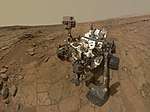Kepler-36
Kepler-36 is a star in the constellation of Cygnus with two known planets. It has an anomalously large radius, meaning that it is a subgiant.
| Observation data Epoch J2000 Equinox J2000 | |
|---|---|
| Constellation | Cygnus |
| Right ascension | 19h 25m 00.0431s[1] |
| Declination | +49° 13′ 54.631″[1] |
| Apparent magnitude (V) | 11.9 |
| Characteristics | |
| Spectral type | G1IV |
| Astrometry | |
| Proper motion (μ) | RA: 0.970±0.041[1] mas/yr Dec.: −8.073±0.043[1] mas/yr |
| Parallax (π) | 1.8654 ± 0.0215[1] mas |
| Distance | 1,750 ± 20 ly (536 ± 6 pc) |
| Details | |
| Mass | 1.071[2] M☉ |
| Radius | 1.626[2] R☉ |
| Temperature | 5911[2] K |
| Metallicity [Fe/H] | −0.2[2] dex |
| Other designations | |
| Database references | |
| SIMBAD | data |
| KIC | data |
Planetary system
On June 21, 2012, the discovery of two planets orbiting the star was announced. The planets, a super-Earth and a "mini-Neptune", are unusual in that they have very close orbits; their semi-major axes differ by only 0.013 AU. The outer planet orbits only 11% further than the inner one. Coupled with masses significantly higher than Earth, their gravitational influence to each other is significant, meaning that their interaction causes extreme transit timing variations for both. Kepler-36b and c have estimated densities of 6.8 and 0.86 g/cm3, respectively.[2] The two planets are close to a 7:6 orbital resonance.[2] The large difference in densities, despite the close proximity of the planets' orbits, is likely due to the large difference in mass.[3] The innermost and less massive planet likely lost most, or all, of the hydrogen/helium envelope acquired during formation.
| Companion (in order from star) |
Mass | Semimajor axis (AU) |
Orbital period (days) |
Eccentricity | Inclination | Radius |
|---|---|---|---|---|---|---|
| b | 4.45 M⊕ | 0.1153 | 13.83989 | <0.04 | 90.0° | 1.486 R⊕ |
| c | 8.08 M⊕ | 0.1283 | 16.23855 | <0.04 | 90.0° | 3.679 R⊕ |
References
- Brown, A. G. A.; et al. (Gaia collaboration) (August 2018). "Gaia Data Release 2: Summary of the contents and survey properties". Astronomy & Astrophysics. 616. A1. arXiv:1804.09365. Bibcode:2018A&A...616A...1G. doi:10.1051/0004-6361/201833051. Gaia DR2 record for this source at VizieR.
- Carter, J. A.; et al. (2012). "Kepler-36: A Pair of Planets with Neighboring Orbits and Dissimilar Densities". Science. 337 (6094): 556–559. arXiv:1206.4718. Bibcode:2012Sci...337..556C. doi:10.1126/science.1223269. PMID 22722249.
- Bodenheimer, P.; Stevenson, D.; Lissauer, J.; D'Angelo, G. (2018). "New Formation Models for the Kepler-36 System". The Astrophysical Journal. 868 (2): id. 138 (17 pp.). arXiv:1810.07160. Bibcode:2018ApJ...868..138B. doi:10.3847/1538-4357/aae928.


